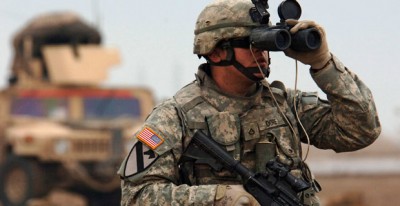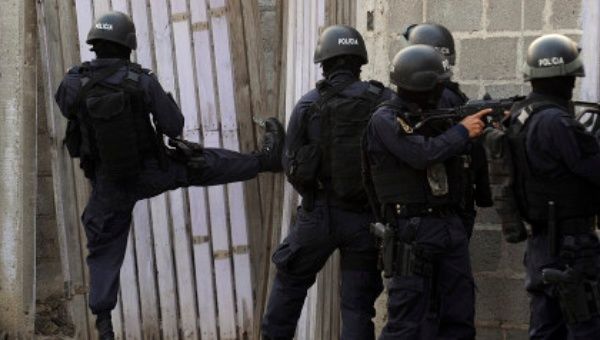“Silent Invasion”: The US and the Militarization of Latin America

For more than two centuries, the United States has viewed Latin America as its “backyard,” a geopolitical sphere of influence where it acts as undisputed hegemon. The history of the Western hemisphere, broadly speaking, reflects this reality as the U.S. has influenced, dominated, and otherwise controlled the political and economic development of most of the countries of Central and South America, as well as the Caribbean.
However, recent years have borne witness to a growing independence and assertiveness from many nations in the region, owing in no small part to the rise of Hugo Chavez in Venezuela. Indeed, with Venezuela as the exemplar, and Chavez as the initiator of the process of regional integration and collective security, Latin America has grown increasingly independent of its imperial neighbor to the north.

Honduras police have been accused of being active in death squads. | Photo: Reuters
And it is precisely this political, economic, and cultural independence that the U.S. has moved to counteract in the most effective way it can: militarily. Using pretexts ranging from the “War on Drugs” to humanitarian assistance, and the “War on Terror,” the U.S. seeks to regain its military foothold in the region, and thereby maintain and further its hegemony.
The Silent Invasion
The deployment of U.S. military forces throughout Central and South America calls to mind the dark days of U.S. imperialism in the region, when Washington installed client regimes and fascist dictatorships for the purpose of controlling the political and economic development of nations that might otherwise have pursued the path of socialism and independence. And it is the memory of those years that is immediately evoked when one critically examines what the U.S. is doing militarily.
In Central America, U.S. military forces have penetrated key countries under the pretext of counter-narcotics operations. In Honduras for example, the U.S. has played a key role in supporting, advising and directing the military of the right-wing government that took control of the country after the 2009 coup, supported by then Secretary of State Hillary Clinton and the Obama administration. As the North American Congress on Latin America (NACLA) reported:
The steady increase of U.S. assistance to [Honduran] armed forces [is] an indicator of tacit U.S. support. But the U.S. role in militarization of national police forces has been direct as well … The US [DEA] Foreign-deployed Advisory Support Team (FAST) … set up camp in Honduras to train a local counternarcotics police unit and help plan and execute drug interdiction operations … these operations were nearly indistinguishable from military missions … According to the New York Times, five “commando style squads” of FAST teams have been deployed across Central America to train and support local counternarcotics units … In July 2013, the Honduran government created a new “elite” police unit called the Intelligence Troop and Special Security Group, or TIGRES (Spanish for “tigers”). The unit, which human rights groups contend is military in nature, has been deployed in tandem with the new military police force and has received training in military combat tactics from both U.S. and Colombian Special Forces units.
The deployment of this sort of combination of military, paramilitary, and militarized law enforcement is indicative of the U.S. strategy for re-militarizing the region. Rather than simply overt military occupation, Washington “provides assistance” in the form of military aid. This is further demonstrated by therecent announcement of a contingent of U.S. Marines deployed to Honduras, ostensibly to help with relief efforts during hurricane season.
Such deployments keep with recent U.S. initiatives to further penetrate these countries militarily, using small contingents of troops and Special Forces. In 2013, it was reported that in Colombia, former commander of the U.S. Special Operations Command William McRaven, “sought the authority to deploy [Special Operations Forces] teams to countries without consulting either U.S. ambassadors there or even the U.S. Southern Command (SOUTHCOM) … McRaven’s command even tried to work out an agreement with Colombia to set up a regional special operations coordination centre there without consulting SOUTHCOM or the embassy.” In fact, under McRaven Special Forces troop deployments ballooned to more than 65,000, with many spread throughout Latin America.
Colombia has long been a centerpiece of U.S. military strategy. Perhaps the most well-known U.S. regional program is Plan Colombia, launched by the Clinton administration and expanded under George W. Bush. As Foreign Affairs documented in 2002, “The Clinton administration shifted its emphasis from a comprehensive counterdrug program … to a policy that focused on the provision of military assistance and helicopters.”
Undoubtedly, Plan Colombia was always about militarization and protecting economic interests. In fact, just totaling the military, police, and economic aid to Colombia for 2010-2015, the U.S. has given nearly US$3 billion to Colombia in the form of “aid” to fight the so-called “War on Drugs.”
Under Obama, the U.S. military has expanded on the Clinton/Bush administration programs, especially with the Mérida Initiative (launched in 2008 by Bush) and the Central American Regional Security Initiative (CARSI) created by Obama in 2011. According to the Igarapé Institute, CARSI and Mérida alone received more than US$2.5 billion (2008-2013). It is an open secret that the massive funding has been channeled primarily into military and paramilitary programs. Though the U.S. touts these programs as success stories, their expansion has coincided with increased militarization in every country where U.S. funds have been provided.
In El Salvador, the Funes government has consolidated military control of law enforcement in the interests of its U.S. backers. These changes took place simultaneous to the implementation of CARSI, and should be seen as an outgrowth of U.S. militarization. In Guatemala, the government of Otto Pérez Molina, a former military leader with a record of atrocities and genocide, has further militarized the country.
Similarly, Honduras has been transformed into the U.S. military’s primary foothold in Central America. U.S. Coordinator of the National Popular Resistance Front (FNRP) and Refoundation Party (LIBRE) Lucy Pagoada explained in a 2015 interview that “[Honduras] has turned into a large military base trained and funded by the U.S. They even have School of the Americas forces there …There have been high levels of violence and torture since the [2009] coup.”
Of course these examples merely scratch the surface of U.S. military engagement. Aside from its long-standing partnership with Colombia, the U.S. military has now further entrenched its position thereby establishing NATO-Colombia cooperation. Naturally, such announcements have been met with consternation by independent leaders such as Daniel Ortega of Nicaragua who described the NATO-Colombia deal as a “knife in the back of the people of Latin America.”
The US Agenda
Ultimately, U.S. militarization in Latin America is an attempt to check militarily the rise of regional cooperation and independence. The development of ALBA, Unasur, PetroCaribe, and other multilateral institutions not controlled by the U.S. has alarmed many in Washington who see their former “backyard” slipping out of their grasp. And so, the U.S. has moved to block this development with military force.
The regional component is also critical to the U.S. militarization agenda. Washington wants to block any further integration, while also checking the growing influence of China and other non-western actors who are increasingly penetrating the region through investments. Essentially, the U.S. is doing in the Americas, what it is doing in Africa, the Middle East, and the Asia-Pacific regions: using its military to block independent development.
Perhaps this is an unavoidable part of imperialism. Perhaps it is indicative of an Empire’s waning influence and its desperate attempt to recapture lost spheres of influence. However one interprets its motives, the U.S. is unmistakably consolidating its military power in Latin America. Whether this allows the Empire to reassert control, or is simply a doomed attempt at reestablishing hegemony, only time will tell.
Eric Draitser is an independent geopolitical analyst based in New York City. He is the editor of StopImperialism.org and host of CounterPunch Radio. You can reach him at [email protected].

